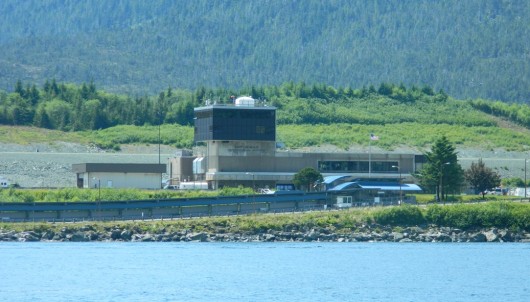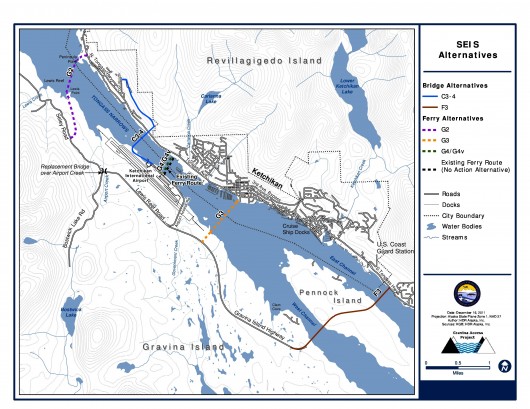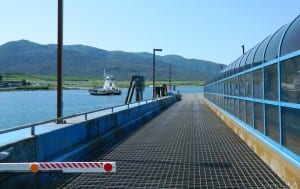A couple of Alaska Department of Transportation officials were in Ketchikan Monday to kick off a series of input-gathering meetings related to the new Statewide Transportation Improvement Plan, or STIP.
The STIP is a plan for transportation projects that receive federal funding. A mandatory part of the STIP process is public meetings in affected communities.
During the Ketchikan meeting, Southcoast Region Planning Chief Andy Hughes and Transportation Planner Marie Heidemann heard some compliments – specifically about this summer’s paving of the former gravel section on South Tongass Highway.
They also heard some concerns. Patricia Finney lives on North Tongass Highway, just past the First Waterfall bridge, which, along with Second Waterfall Bridge, is on the STIP list for improvements.
“Thankfully, there’s only two of you,” she said. “I brought for each of you a picture of my bridge, I call it.”
Finney said her bridge is in serious need of improvements, and she’s worried what will happen if something isn’t done soon. She notes that DOT has done some mitigation, such as lowering the load limit, and installing a steel plate on the bridge deck.
“So, the steel plate is there to protect (from) the vibration,” she said. “If you or anybody was to come out there and stand on that bridge, with just a passenger vehicle coming across it, and the vibration that it is, somebody would know what the real condition of that bridge is.”
Finney is concerned not only about her own ability to access her home, but also about access for emergency vehicles to that end of the road, and the general public’s access to Settlers Cove State Park and the Forest-Service-maintained Lunch Creek Trail, both located at the far end of North Tongass.
Finney suggested at least lowering the speed limit over the bridge until the project is ready for construction. Hughes agreed that would help limit continued damage.
“The speed of a load going across a bridge creates a dynamic force that also impacts a bridge,” he said. “I will carry your concerns back to our highway safety engineer and safety people. I guess the concern would be if people aren’t slowing down, how do we slow them down?”
It will be at least a couple years still before work begins. Heidemann looked the project up on the STIP, and said construction is expected to start in summer of 2017.
Hughes said they’ll move it up if they can. “But, no promises there. The federal aid process is pretty fixed.”
Heidemann added, “It’s a high-priority project, and I don’t expect any problems with funding. If there’s a problem, it’s as Andy said, it’s going to be with the process. I don’t think we’re going to lose the funding with this project.”
“It’s our goal is to address all the bridges on our bridge deficiency list,” Hughes said. “These being two of them.”
Speaking of bridges, or lack of them, the Gravina Access project also came up during the Ketchikan STIP meeting.
Bill Rotecki, who is a Ketchikan Gateway Borough Assembly member, asked about the $1.5 million designated in the STIP for the project, which originally was to be the $300-plus-million, infamous Bridge to Nowhere, but now most likely will be improved ferry service.
Hughes said there is still $75 million reserved from the original, controversial, federal earmark. But none of that can be used until the Environmental Impact Statement is done. He said the last remaining step for the EIS is a decision from the governor’s office.
“Every EIS ends with a Record of Decision. We’re at the point of decision,” he said.
Rotecki responded: “I hear that kind of laughingly. I haven’t kept track, but it’s been any number of times that we’ve been told three months, six months. It’s been five years or something, that we’ve been told there’s a decision, there’s a decision, there’s a decision. The community here has invested a huge amount into it, and looks forward to some kind of decision.”
“We have a new governor, and I think he just wants to make a well-informed decision and wants to take the time to consider it,” Hughes said. “He’s been pretty busy, you have to admit, in the last few months, with other matters.”
He was referring to the state’s $3 billion budget deficit, which led to significant cuts in state spending and two special legislative sessions.
Despite state budget cuts, though, both DOT representatives told the small Ketchikan crowd that matching state funds for federally financed projects most likely will remain in place.
Additional regional STIP meetings are scheduled for Wednesday in Sitka, and Thursday in Juneau. Two more meetings next week will gather input in Kodiak and King Salmon.
If you missed the meeting and want to provide comments, you can do so online: http://dot.alaska.gov/stwdplng/cip/stip/index.shtml








